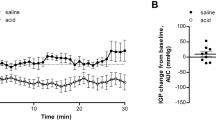Abstract
Misoprostol, a synthetic prostaglandin analog, has been reported to inhibit gastric acid secretion and to protect the gastric mucosa from the effects of aspirin and aspirin plus hemorrhagic shock. This study examined the effect of misoprostol on basal gastric corpus mucosal blood flow (MBF), and on pentagastrin-stimulated gastric acid output and MBF. Gastric corpus MBF in ml/min/100 g was measured by hydrogen gas clearance in fasted, anesthetized rats. Acid output in μeq/min was determined by a continuous gastric perfusion technique. For the basal study, vehicle or misoprostol in doses of 50 and 1000 μg/kg was administered intragastrically in separate groups of rats. For the pentagastrinstimulation study, vehicle or misoprostol, 1000 μg/kg, was infused intravenously after gastric acid output was stimulated to plateau by intravenous pentagastrin, 20 μg/kg/hr. The results showed that misoprostol had no effect on basal gastric corpus MBF. During pentagastrin stimulation, misoprostol decreased acid secretion but did not decrease gastric corpus MBF. We speculate that this dissociated effect of misoprostol on stimulated gastric acid secretion and corpus MBF may be of therapeutic importance if it can be confirmed in human studies.
Similar content being viewed by others
References
Robert A, Nezamis JE, Lancaster C, Hanchar AJ: Cytoprotection by prostaglandins in rats: Prevention of gastric necrosis produced by alcohol, HCl, NaOH, hypertonic NaCl, and thermal injury. Gastroenterology 77:433–443, 1979
Robert A: Cytoprotection by prostaglandins. Gastroenterology 77:761–767, 1979
Jacobson ED, Chaudbury TK, Thompson WJ: Mechanism of gastric mucosal cytoprotection by prostaglandins. Gastroenterology 70:897, 1976
Gerkens JF, Gerber JG, Shand DG, Branch RA: Effect of PGI2, PGE2, and 6-keto PGF1α on canine gastric blood flow and acid secretion. Prostaglandins 16:815–823, 1978
Konturek SJ, Robert A, Hanchar AJ, Nezamis JE: Comparison of prostacyclin and prostaglandin E2 on gastric secretion, gastrin release, and mucosal blood flow in dogs. Dig Dis Sci 25:673–679, 1980
Gerber JG, Nies AS: Canine gastric mucosal vasodilation with prostaglandins and histamine analogs. Dig Dis Sci 27:870–874, 1982
Konturek SJ, Robert A: Cytoprotection of canine gastric mucosa by prostacyclin: Possible mediation by increased mucosal blood flow. Digestion 25:155–163, 1982
Inatomi N, Maki Y: Effect of prostaglandins on mucosal blood flow and aspirin-induced damage in the canine stomach. Jpn J Pharmacol 33:1263–1270, 1983
Cheung LY: Topical effects of 16,16-dimethyl prostaglandin E2 on gastric blood flow in dogs. Am J Physiol 238:G514-G519, 1980
Gerkens JF, Flexner C, Oates JA, Shand DG: Prostaglandin and histamine involvement in the gastric vasodilator action of pentagastrin. J Pharmacol Exp Ther 201:421–426, 1977
Leung FW, Robert A, Guth PH: Gastric mucosal blood flow in rats after administration of 16,16-dimethyl prostaglandin E2 at a cytoprotective dose. Gastroenterology 88:1948–1953, 1985
Colton DG, Callison DA, Dajani EZ: Effects of a prostaglandin E1 derivative, SC-29333 and aspirin on gastric ionic fluxes and potential difference in dogs. J Pharmacol Exp Ther 210:282–288, 1979
Larsen KR, Jensen NF, Davis EK, Jensec JC, Moody FG: The cytoprotective effects of (±)-15-deoxy-16-α, β-hydroxy-16 methyl PGE1 methyl ester (SC-29333) versus aspirin-shock gastric ulcerogenesis in the dog. Prostaglandins 21(Suppl):119–124, 1981
Leung FW, Guth PH, Scremin OU, Colanska EM, Kauffman GL Jr: Regional gastric mucosal blood flow measurements by hydrogen gas clearance in the anesthetized rat and rabbit. Gastroenterology 87:28–36, 1984
Murakami M, Moriga M, Miyake T, Uchino H: Contact electrode method in hydrogen gas clearance technique: A new method for determination of regional gastric mucosal blood flow in animals and humans. Gastroenterology 82:457–467, 1982
Aukland K, Bower BF, Berliner RW: Measurement of local blood flow with hydrogen gas. Circ Res 14:164–187, 1964
Kety SS: Theory of blood-tissue exchange and its application to measurement of blood flow.In Methods in Medical Research, Vol. VIII. HD Bruner (ed). Chicago, Year Book Publishers, 1960, pp 223–227
Boughton-Smith NK, Vane JR, Whittle BJR: Effects of prostacyclin (PGI2), PGI1 and 6-oxo-PGF1 on the rat gastric mucosa. Br J Pharmacol 62:413P, 1978
Gaskill HV III, Sirinek KR, Levine BA: Prostacyclin increases gastric mucosal blood flow via cyclic AMP. J Surg Res 33:140–145, 1982
Puurunen J: Effect of prostaglandin E2, cimetidine, and atropine on ethanol-induced gastric mucosal damage in the rat. Scand J Gastroenterol 15:485–488, 1980
Gaskill HV, Sirinek KR, Levine BA: PGE1 protects gastric mucosal blood flow during hypovolemic shock. Surg Forum 31:123–124, 1980
McGreevy JM, Moody FG: Protection of gastric mucosa against aspirin-induced erosions by enhanced blood flow. Surg Forum 28:357–359, 1977
Wallace JL, Morris GP, Krausse EJ, Greaves SE: Reduction by cytoprotective agents of ethanol-induced damage to the rat gastric mucosa: A correlated morphological and physiological study. Can J Physiol Pharmacol 60:1686–1699, 1982
Miller TA, Henagan JM, Robert A: Effect of 16, 16-dimethyl PGE2 on resting and histamine-stimulated gastric mucosal blood flow. Dig Dis Sci 25:561–567, 1980
Colton DG, Driskill DR, Phillips EL, Poy P, Dajani EZ: Effect of SC-29333, an inhibitor of gastric secretion, on canine gastric mucosal blood flow and serum gastrin levels. Arch Int Pharmacodyn Ther 236:86–95, 1978
Muller-Lissner SA, Sonnenberg A, Blum AL: Does gastric aminopyrine clearance reflect gastric mucosal blood flow or parietal cell function? Gut 23:997–1002, 1981
Cheung LY, Lowry SF: Effects of intraarterial infusion of prostaglandin E1 on gastric secretion and blood flow. Surgery 83:699–704, 1978
Leung FW, Guth PH: Dissociated effects of somatostatin o gastric acid secretion and mucosal blood flow. Am J Physiol 248:G337-G341, 1985
Larsen KR, Maas VA, Carlsson E: The effects of omeprazole, a proton pump inhibitor, on pentagastrin-stimulated blood flow and oxygen consumption in the ex-vivo canine gastric chamber. Gastroenterology 86:1153, 1984 (abstract)
Cheung LY, Sonnenschein LA: Effect of cimetidine on canine gastric mucosal pH and blood flow. Am J Surg 145:24–29, 1983
Author information
Authors and Affiliations
Additional information
This work was supported by a grant from GD Searle & Company and Veterans Administration Research funds.
Rights and permissions
About this article
Cite this article
Leung, F.W., Miller, J.C. & Guth, P.H. Dissociated effects of misoprostol on gastric acid secretion and mucosal blood flow. Digest Dis Sci 31 (Suppl 2), 86S–90S (1986). https://doi.org/10.1007/BF01309329
Issue Date:
DOI: https://doi.org/10.1007/BF01309329




